How to Keep Predators Away from Your Frog Pond: Simple and Effective Tips
Keeping frogs safe in your backyard pond can be tricky. Lots of animals like to eat frogs.
But don’t worry! There are easy ways to protect your amphibian friends.
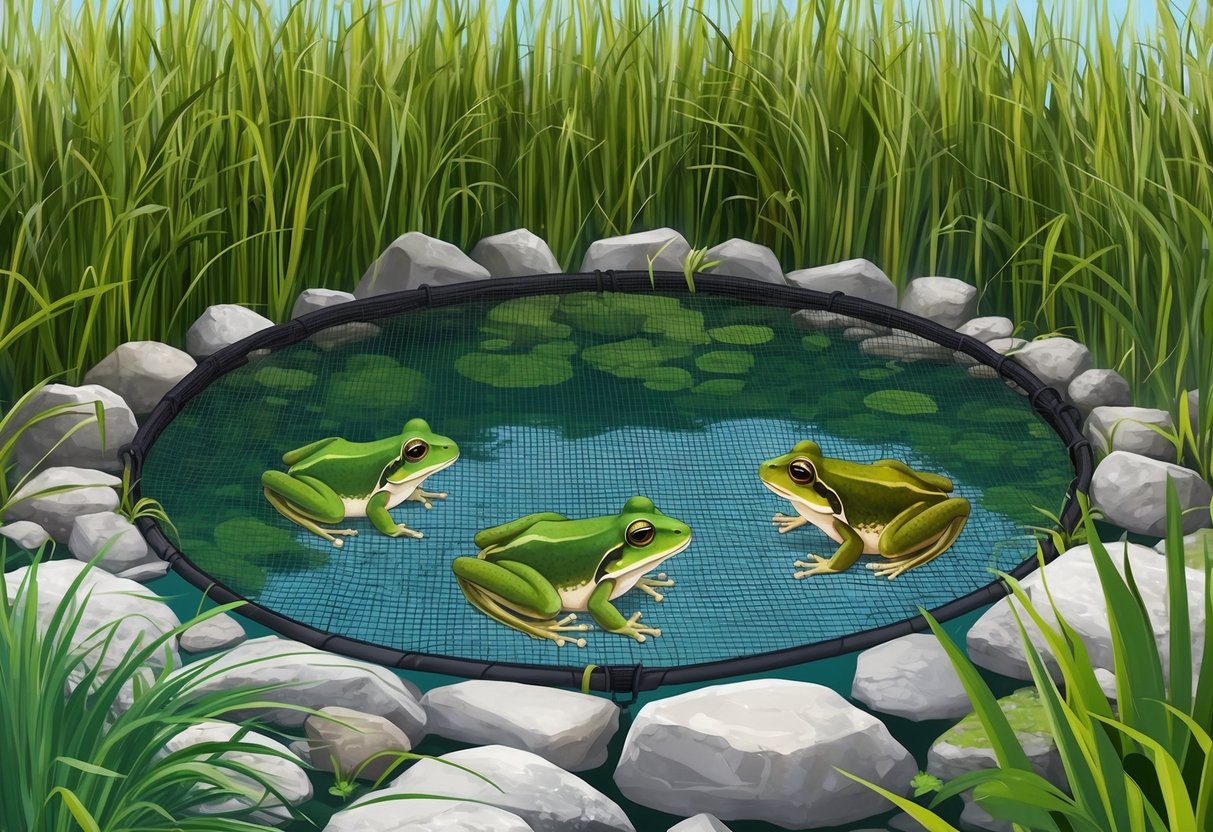
Making your pond safe for frogs means using a mix of natural and man-made solutions. You can add plants for hiding spots, use nets or fences, and even try special devices that scare predators away. These tricks help frogs stay happy and healthy in your pond.
A frog-friendly pond brings nature to your yard. It’s fun to watch frogs grow and hear them sing at night.
With some simple steps, you can create a safe home for frogs and enjoy their company for years to come.
Key Takeaways
- Use plants and covers to give frogs places to hide from danger
- Add special devices like sprayers or lights to scare away predators
- Keep your pond clean and maintain it regularly to help frogs stay healthy
Understanding Frog Predators
Frogs face many threats in their pond habitats. Knowing these dangers helps protect them better. Various animals hunt frogs, and they use different methods to catch their prey.
Common Predators in Pond Ecosystems
Frogs have many enemies in and around ponds. Birds like herons and egrets often hunt frogs. They wade in shallow water and use their long beaks to catch them.
Snakes are another big threat. Water snakes and garter snakes swim well and eat lots of frogs. Some fish also prey on frogs, especially larger species like bass and pike.
On land, raccoons and opossums search for frogs at night. They have good eyesight and clever paws for catching them. Even some insects pose a risk. Giant water bugs can eat small frogs and tadpoles.
Predator Behavior and Feeding Patterns
Predators use different tricks to catch frogs. Some, like herons, stand very still and wait for frogs to come close. Others, like raccoons, actively search and dig for frogs.
Many predators hunt at night when frogs are most active. Nocturnal animals have great hearing and smell to find frogs in the dark. Some use vibrations in the water to locate their prey.
Seasonal changes affect hunting too. In spring, predators often target frog eggs and tadpoles. They’re easy meals in large numbers. As winter nears, predators may eat more frogs to fatten up for the cold months.
Designing a Frog-friendly Pond
A well-designed frog pond offers protection and a cozy home for amphibians. The right layout keeps frogs safe while making them feel welcome in your backyard.
Creating Natural Barriers
Natural barriers help shield frogs from harm. Plants around the pond’s edge act as cover. Tall grasses and shrubs give frogs places to hide.
Rocks and logs near the water create more spots for frogs to rest. These items also make it harder for predators to reach the pond. A mix of plants and objects works best.
Sloped sides let frogs hop in and out easily. This helps them escape if they sense danger. Shallow areas with plants give tadpoles a safe place to grow.
Pond Depth and Edge Design
The right depth and edge design are key for frog safety. A pond should be at least 1 foot deep in the center. This gives frogs a cool spot in hot weather.
Edges should slope gently into the water. This lets frogs enter and exit with ease. Steep sides can trap frogs in the pond.
A mix of depths creates different zones for frogs. Shallow areas near the edge are great for tadpoles. Deeper sections in the middle offer a safe retreat.
Adding a small fountain can help. Moving water attracts frogs and keeps the pond fresh. But avoid strong currents that might sweep away tadpoles.
Habitat Enrichment Strategies
Creating a diverse and protective environment is key to keeping predators away from your frog pond. By adding natural elements, you can make the habitat safer and more comfortable for frogs.
Vegetation Cover for Safety
Planting aquatic vegetation around and in your frog pond offers great protection. Water lilies and floating plants like frogbit provide excellent cover. These plants make it harder for predators to spot frogs from above.
Tall grasses and reeds along the pond’s edge create a natural barrier. They offer hiding spots and make it trickier for predators to access the water. Native plants are best, as they attract insects for frogs to eat.
Consider adding submerged plants too. These give frogs places to hide underwater when they feel threatened. Elodea and hornwort are good options that grow well in ponds.
Providing Hiding Spots
Adding hiding spots in and around the pond gives frogs quick escape routes. Hollow logs or pieces of driftwood make great shelters. Place them partially in the water so frogs can easily access them.
Rock piles or stacks of flat stones create cozy nooks for frogs. Position these near the water’s edge. Frogs can slip between the rocks to stay safe from birds and other predators.
Artificial hideaways work well too. Half-buried clay pots or specially designed frog houses provide safe spaces. Place these around the pond’s perimeter for easy frog access.
Remember to keep some open areas. Frogs need spots to bask in the sun and catch insects. A mix of cover and open space creates an ideal habitat.
Safe Water Practices
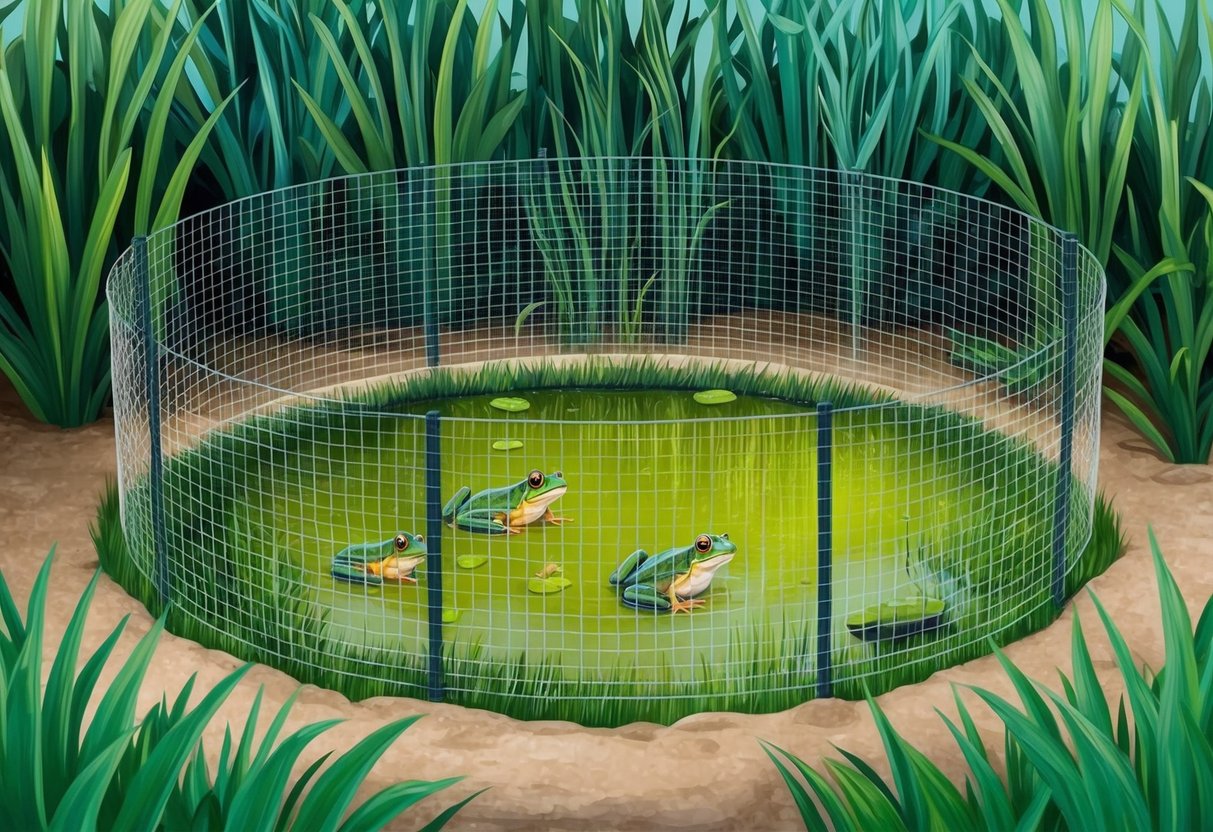
Good water practices are key to keeping frogs safe from predators. Clean, deep water with hiding spots makes it harder for hunters to catch frogs.
Maintaining Water Quality
Clean water is vital for frog health and safety. Test the water often to check pH and chemical levels. Use a filter to remove dirt and waste. Change some of the water each week to keep it fresh.
Add water plants like lily pads and frogbit. These give frogs places to hide from birds and other threats. Plants also help clean the water and add oxygen.
Don’t use harsh chemicals in or near the pond. They can hurt frogs and kill the bugs they eat. Pick up trash and leaves to stop the water from getting dirty.
Water Depth Variations
A pond with different depths protects frogs better than a shallow one. Make sure some areas are at least 2-3 feet deep. This gives frogs safe spots to dive when danger comes.
Deep spots in the pond let frogs stay safe in winter too. They can rest at the bottom where it’s warmer.
Add some shallow areas with plants and rocks. Frogs like to sit here to warm up and catch bugs. But they can quickly swim to deeper water if they see a predator.
Frog Pond Maintenance
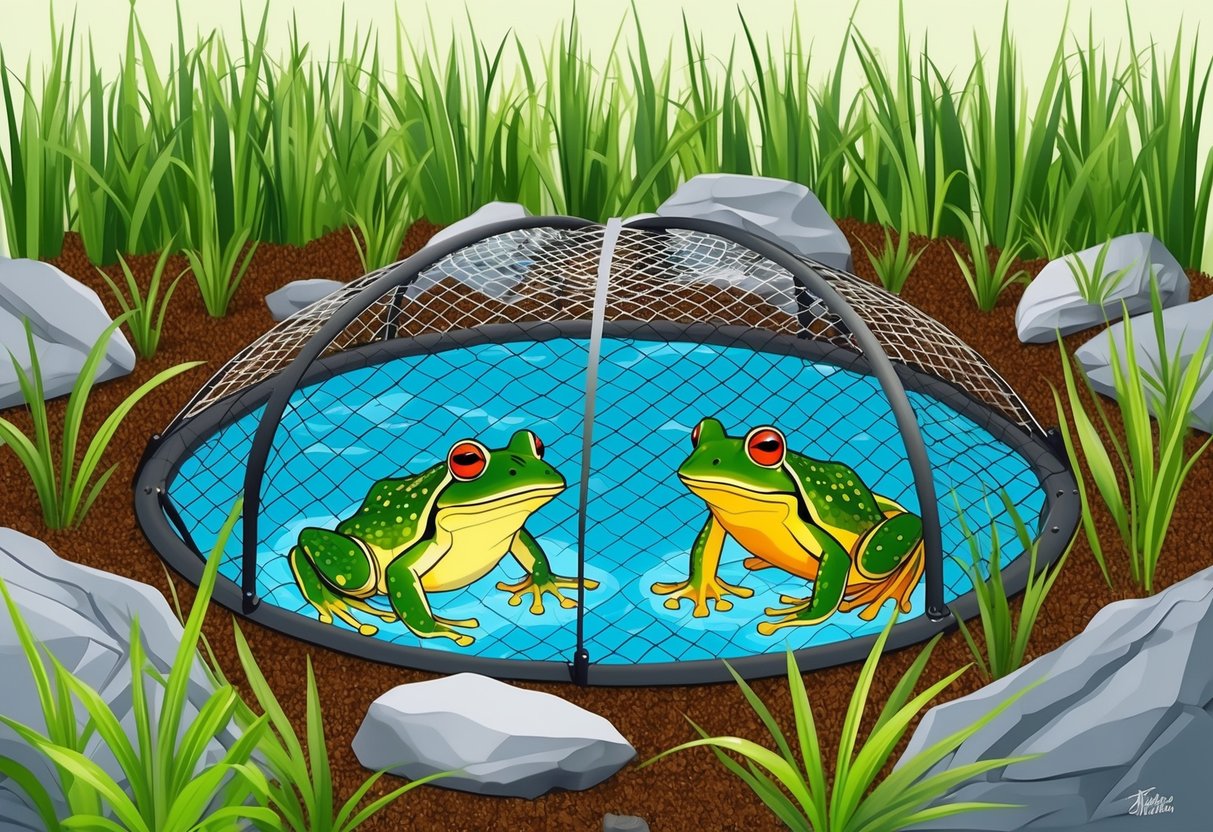
Keeping a frog pond healthy requires regular upkeep and care. Proper maintenance ensures a thriving habitat for frogs and other pond life.
Regular Pond Inspections
Check your frog pond at least once a week. Look for signs of predator activity like footprints or disturbed areas around the edges. Make sure water levels are stable and top up if needed.
Inspect the pond liner for any tears or leaks. Small holes can be patched, but larger damage may require professional repair.
Test the water quality monthly. Use test strips to check pH, ammonia, and nitrate levels. Aim for a pH between 6.5 and 7.5 for most frog species.
Trim back overhanging plants to prevent excess leaves from falling in. This helps maintain water quality and reduces hiding spots for predators.
Managing Algae and Debris
Remove fallen leaves and debris regularly with a pond net. This prevents water from becoming stagnant and unappealing to frogs.
Control algae growth naturally by adding floating plants like water lilies. They provide shade and compete with algae for nutrients.
Use a pond vacuum to clear sludge from the bottom once or twice a year. This improves water quality and removes potential hiding spots for frog-eating insects.
If algae becomes a problem, consider adding beneficial bacteria. These help break down organic matter and reduce nutrients that feed algae growth.
Physical Deterrents and Barriers
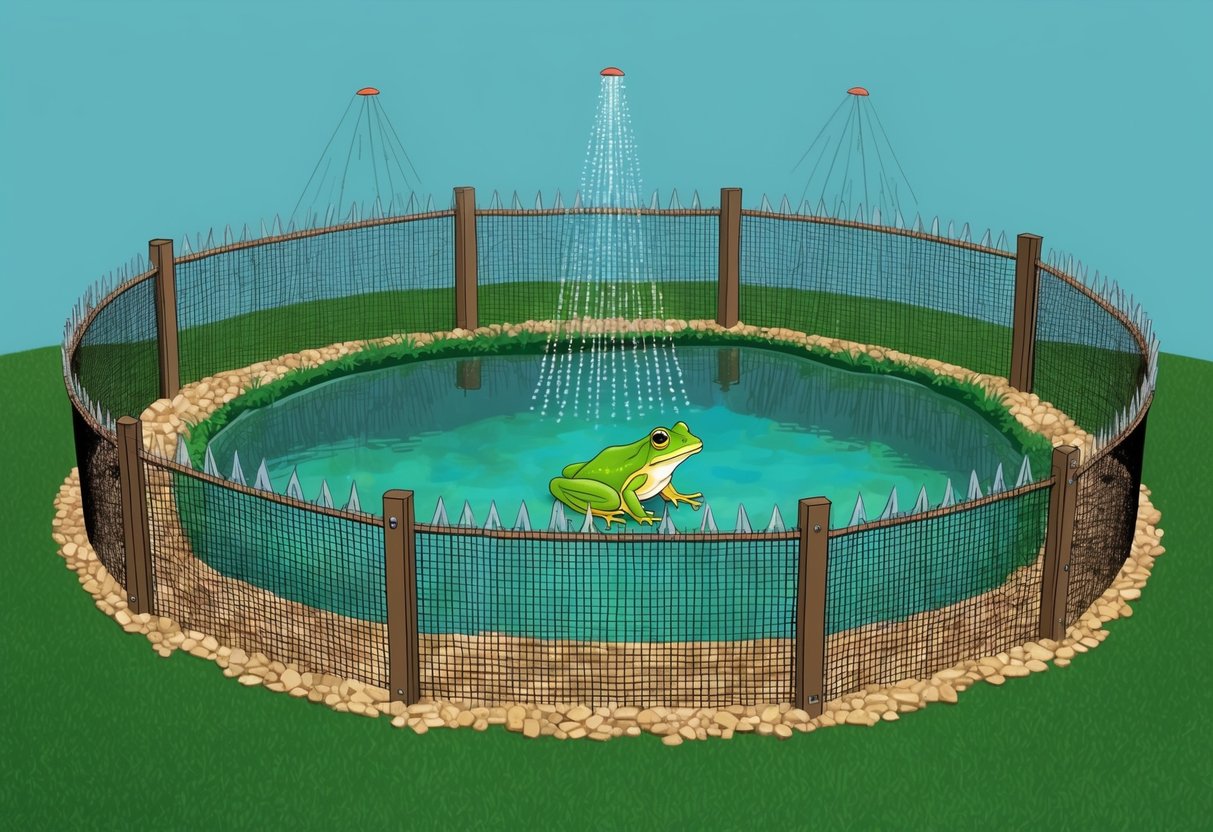
Protecting your frog pond from predators can be done with physical barriers and decoys. These methods create obstacles and trick potential threats, keeping your amphibian friends safe.
Fencing Options
Fencing is a great way to keep predators out of your frog pond. A sturdy fence at least 3 feet tall can stop many animals from getting in. Use materials like chicken wire or hardware cloth with small holes.
Make sure the fence is buried 6-12 inches deep. This stops diggers from tunneling under. Add a rolled top to the fence to prevent climbers from getting over.
For smaller ponds, consider a mesh cover. This blocks flying predators like birds. Choose a fine mesh that still lets light through for plants.
Decoy Predators
Decoy predators can scare real ones away from your frog pond. Fake owls, hawks, or even alligator heads can work well. Place them near the pond where they’re easily seen.
Move the decoys every few days. This makes them seem more real to animals. Some decoys have moving parts or make sounds, which helps fool predators.
You can also use reflective objects like old CDs or pinwheels. The flashing light scares many animals. Hang these items near the pond or on nearby trees.
Remember to change up your decoys often. Animals can get used to them if they stay in one spot too long.
Biological Control Methods
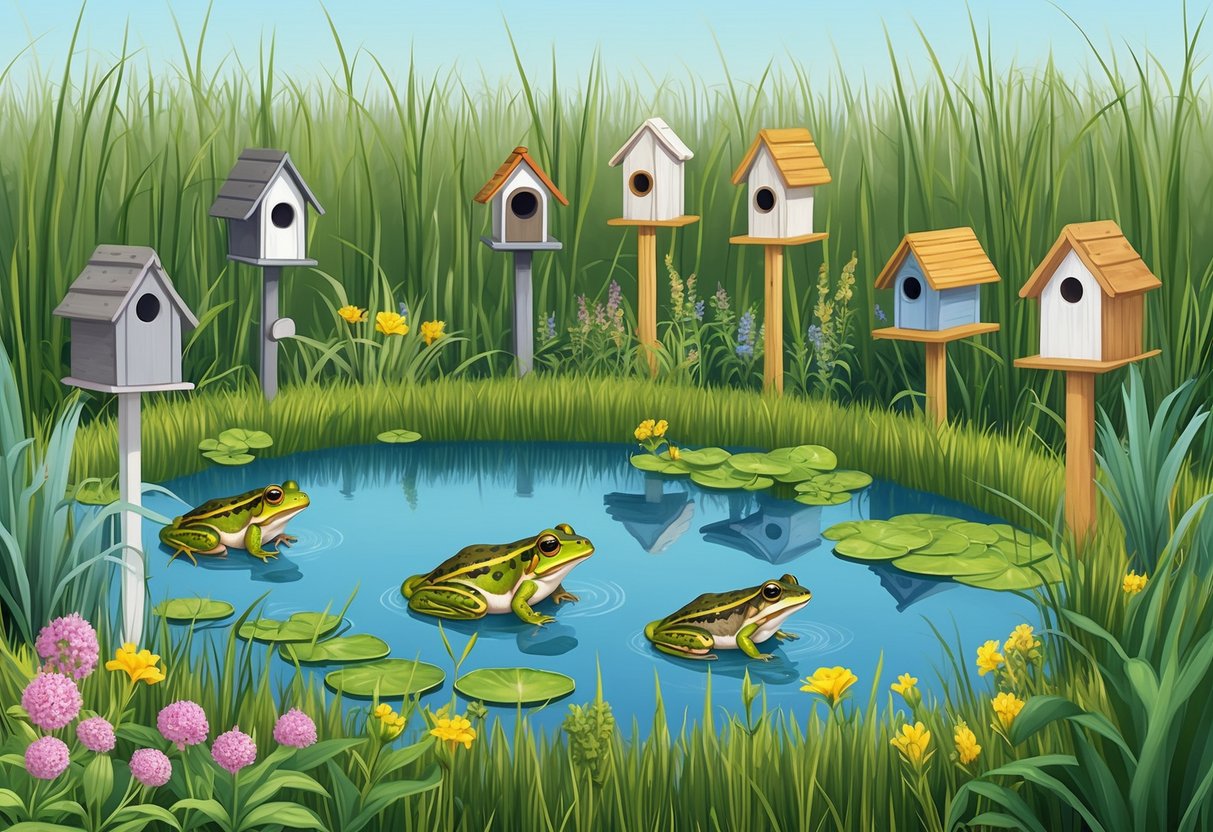
Natural methods can keep predators away from frog ponds without harmful chemicals. These approaches work with nature to create a balanced ecosystem that protects frogs.
Attracting Natural Predator Deterrents
Plant cover like water lilies and frogbit helps hide frogs from threats. These plants also improve water quality.
Encouraging beneficial insects can deter larger predators. Dragonflies eat mosquitoes that prey on tadpoles. Beetles and water striders create surface movement that scares away birds.
Some gardeners add decoy predators like plastic herons or owls. These can trick real predators into avoiding the area. Moving the decoys regularly keeps them effective.
Balancing the Pond Ecosystem
A healthy pond naturally deters predators. Clean water and ample plants support frog populations. This makes it harder for predators to catch them all.
Adding fish like koi or goldfish creates competition for food. This can discourage some predators from viewing the pond as an easy meal source.
Varying pond depth gives frogs safe spots. Shallow areas let them sun, while deeper zones offer protection. Steep sides make it harder for land predators to enter.
Proper filtration keeps water clear. This helps frogs spot danger and find hiding spots quickly. It also supports healthy plant growth for more cover.
Technology and Innovation
New gadgets can help keep predators away from frog ponds. These tools use smart tricks to scare off unwanted visitors and keep frogs safe.
Motion-Activated Sprinklers
Motion-activated sprayers are a clever way to protect small ponds. They can spot movement up to 40 feet away.
When a predator comes close, the sprinkler turns on and sprays water. This sudden splash of water startles animals and makes them run away.
These sprinklers work well for ponds under 1200 square feet. They’re easy to set up and don’t harm animals. The surprise of water is enough to keep most predators away. Frogs can still enjoy the pond, but hungry visitors will think twice before coming back.
Electronic Sound Emitters
Electronic sound devices are another high-tech option for frog pond protection. These gadgets make noises that scare off predators but don’t bother frogs. They can play sounds of bigger predators or make weird noises that animals don’t like.
Some devices change their sounds often. This stops animals from getting used to one noise. Others turn on only when they sense movement nearby. This saves power and doesn’t make noise all the time. Pond owners can place these around the water to create a sound barrier that keeps frogs safe.
Community Engagement
Engaging the local community can help protect frog ponds from predators. People who understand the importance of these habitats are more likely to help keep them safe.
Educational Opportunities
Setting up informational signs near frog ponds can teach visitors about the local wildlife. These signs can explain why it’s important not to feed or disturb animals in the area.
Schools can organize field trips to frog ponds. Kids can learn about the pond ecosystem and the animals that live there. This hands-on experience can make them more invested in protecting frogs.
Local nature centers can host workshops about frog conservation. These events can cover topics like:
- Frog species in the area
- Threats to frog populations
- How to create frog-friendly gardens
Working with Local Conservationists
Partnering with local conservation groups can provide expert knowledge on protecting frog ponds. These groups often have experience dealing with predator issues.
Volunteers can help monitor frog ponds for signs of predators. They can report any problems to pond owners or local wildlife officials. This early warning system can prevent major damage to frog populations.
Conservation groups may also offer resources like:
- Predator deterrent devices
- Native plant species for pond edges
- Advice on creating safe hiding spots for frogs
Working together, communities can create a network of protected frog habitats. This can help ensure the long-term survival of local frog species.
Frequently Asked Questions
Protecting frog ponds from predators involves natural methods, DIY solutions, and safe strategies. These approaches help safeguard both frogs and other pond inhabitants like koi fish.
What are some natural methods to deter predators from my frog pond?
Adding fish or ducks to the pond can create a balanced ecosystem. This helps control frog populations and deter some predators.
Planting thick vegetation around the pond edges provides cover for frogs. It makes it harder for predators to spot and catch them.
What DIY solutions can I use to prevent predators from accessing my pond at night?
Installing motion-activated lights around the pond can startle nighttime predators. This often scares them away before they reach the water.
Motion-activated sprinklers can also work well. They spray water when movement is detected, surprising potential threats.
How can I protect my pond from predators without harming the wildlife?
Creating hiding places for fish and frogs is a safe and effective method. Underwater caves or plants give pond inhabitants places to escape.
Using netting over the pond can prevent larger predators from accessing the water. It’s important to ensure the netting is visible to avoid trapping birds.
What are effective ways to safeguard a koi pond from potential threats?
Installing a pond alarm system can alert owners to unusual activity. These devices detect changes in water level or movement on the surface.
Building a partial fence around the pond can deter some predators. It’s best to leave one side open for wildlife to access water if needed.
Why have my fish suddenly disappeared from my pond, and how can I prevent this?
Predators like herons or raccoons may be visiting at night. Setting up a wildlife camera can help identify the culprit.
Adding floating decoys that look like predators can scare away real threats. Rotating their positions regularly keeps them effective.
Can you suggest some strategies to stop wildlife from entering my koi pond?
Creating steep pond edges makes it harder for animals to enter or exit. This deters predators while still allowing koi to swim freely.
Using ultrasonic repellent devices can keep some animals away. These devices emit high-frequency sounds that bother many predators but are safe for fish.
